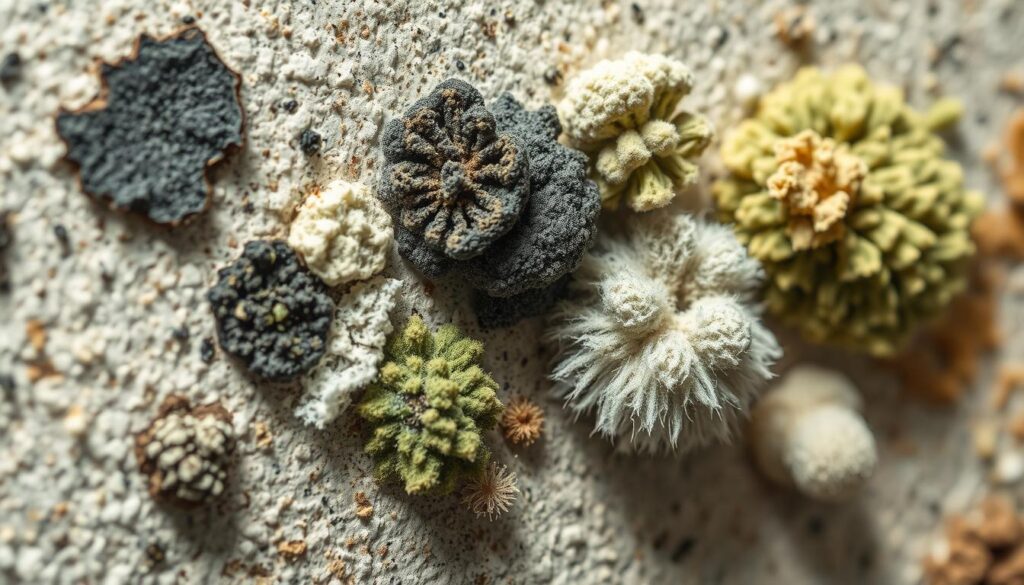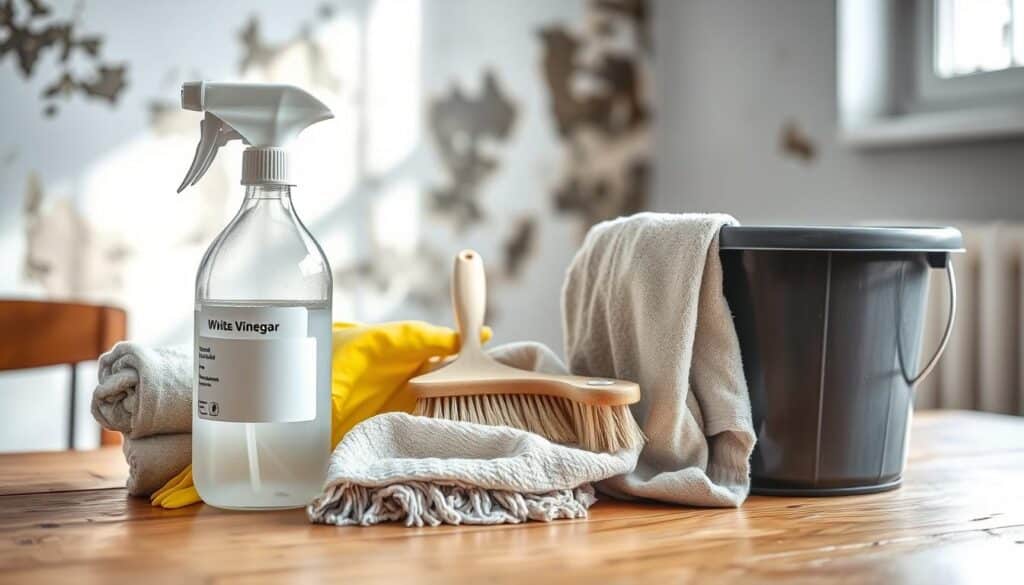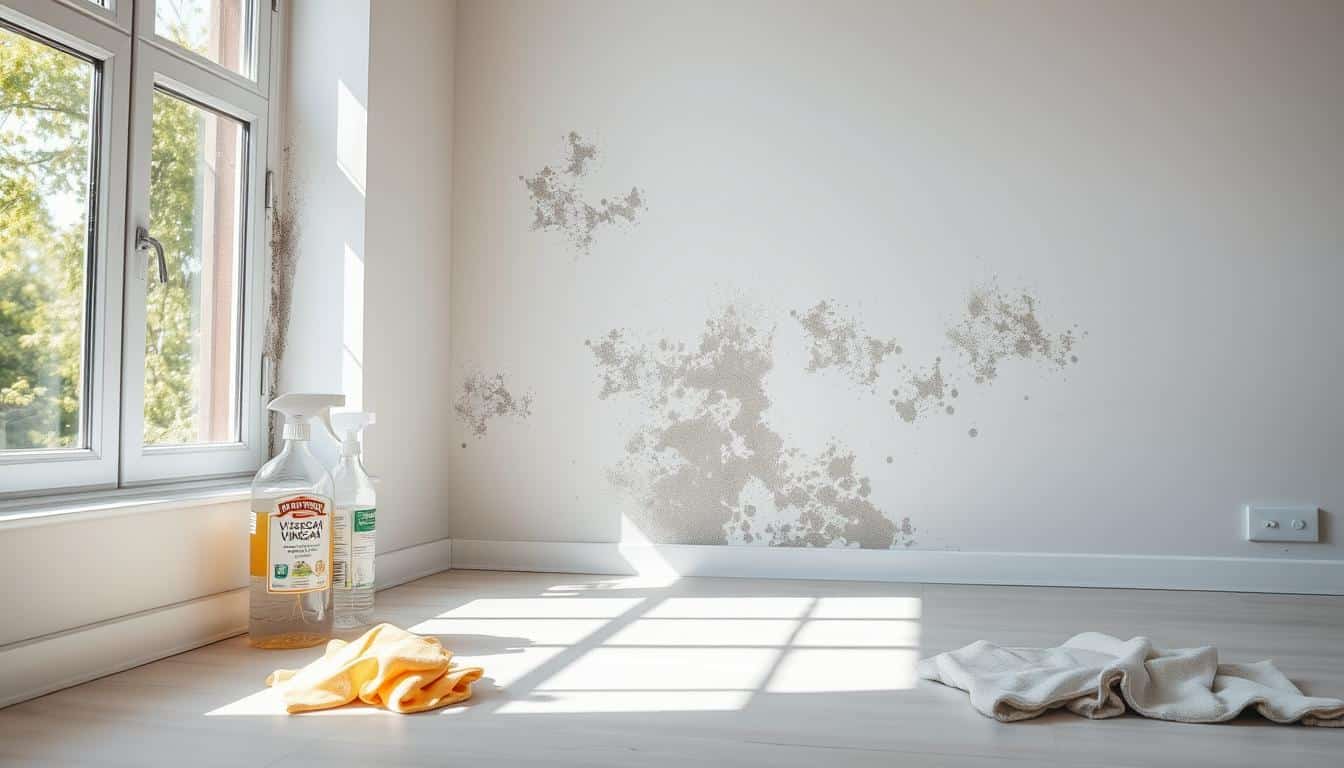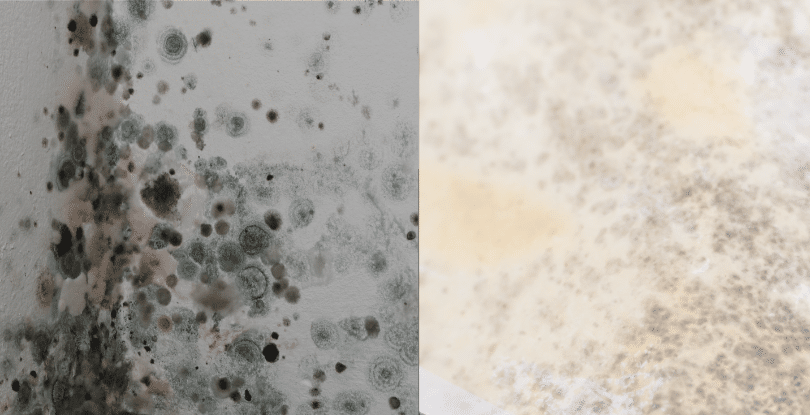Did you know vinegar can kill over 82% of mold species, including black mold? It’s a natural, eco-friendly way to fight household mold. This mold can cause breathing problems and sickness. It loves warm, dark, damp spots, like bathrooms and kitchens.
Vinegar is great for small mold problems. But, for big infestations, you need a pro. Still, vinegar is cheap and works well for small mold issues.
Key Takeaways
- Vinegar can kill over 82% of mold species, making it more effective than bleach
- Vinegar is a natural, eco-friendly, and affordable solution for household mold
- Mold thrives in warm, dark, damp places like bathrooms, kitchens, and laundry rooms
- Large mold infestations require professional remediation, but vinegar works for occasional growth
- Mixing vinegar with borax, hydrogen peroxide, or baking soda can enhance its mold-killing power
Understanding the Power of Vinegar Against Mold
White distilled vinegar is a strong and natural way to fight mold. It has about 5% acetic acid. This makes it effective against over 80% of mold types, including dangerous black mold. It’s a safer choice than harsh chemicals, as it doesn’t pollute the air.
Why Vinegar is More Effective than Bleach
Bleach might seem like a fast fix for mold, but vinegar is better. Vinegar can reach deep into surfaces, unlike bleach. It’s also safer because it doesn’t release harmful gases like bleach does. Never mix vinegar and bleach, as it can create deadly chlorine gas.
The Types of Mold that Vinegar Can Kill
- Aspergillus
- Cladosporium
- Penicillium
- Alternaria
- Stachybotrys (black mold)
Vinegar can kill many mold types, including hard-to-get rid of black mold. It’s a top choice for homeowners. But, be careful with vinegar on certain surfaces like aluminum and waxed wood.

“Vinegar is a biodegradable and safe option around children and pets, unlike some chemical solutions.”
Preparing to Remove Mold with Vinegar
Before you start using vinegar to get rid of mold, make sure you have the right stuff. You need the right tools and safety gear to do it right.
Gather the Necessary Supplies
Here’s what you’ll need to remove mold with vinegar:
- White vinegar (containing 5-8% acetic acid)
- An empty spray bottle
- Baking soda
- A scrub brush or scouring pad
Protect Yourself with Proper Gear
Mold can be harmful, and vinegar is acidic. So, you need to protect yourself. Here’s what you should wear:
- Non-porous gloves
- Goggles or safety glasses
- A mask that covers your mouth and nose
With the supplies for removing mold with vinegar and the safety gear for vinegar mold removal, you’re ready to go. You’ll remove the mold safely and effectively.

Vinegar is a safe and non-toxic alternative to chemical mold removers, making it suitable for households with pets and children.
Step-by-Step Guide to Removing Mold with Vinegar
Removing mold from your walls is easier than you think. White vinegar is a natural, eco-friendly solution that kills over 80% of mold species, including black mold. By following a few simple steps, you can get rid of mold and keep your walls safe.
Apply Undiluted Vinegar to the Moldy Area
Begin by spraying the moldy area with undiluted white vinegar. Make sure to cover the mold fully. The acetic acid in vinegar kills the fungus. Vinegar’s 5% acidity works best when used undiluted.
Let the Vinegar Sit for an Hour
After spraying, let the vinegar sit for at least an hour. This lets the acetic acid break down the mold. Mold grows in warm, damp places, so letting vinegar work is key.
Scrub Away the Mold with a Baking Soda Solution
After the vinegar has worked, scrub the mold away. Mix a teaspoon of baking soda with two cups of water in a spray bottle. Spray the solution and use a brush to gently scrub the mold and stains. Rinse with clean, warm water.
By following these steps, you can use vinegar to remove mold from your walls. Always wear gloves, goggles, and a mask to protect yourself from mold spores.

How to Remove Mould from Walls with Vinegar
If you’re facing mold on your walls, vinegar can help. It has about 5 to 8% acetic acid. This acid is strong against fungi and bacteria, killing over 82% of mold species.
To remove mold with vinegar, you need a few things:
- Undiluted white vinegar
- Baking soda
- Scrub brush or sponge
- Protective gear (gloves, goggles, and a mask)
Here’s how to do it:
- First, spray the moldy area with undiluted vinegar. Make sure it covers everything.
- Let it sit for at least an hour. This lets the vinegar kill the mold.
- Make a baking soda solution by mixing 1 cup of baking soda with 1 gallon of warm water.
- Scrub the area with the baking soda solution using a brush or sponge.
- Finally, rinse it well with clean water to get rid of any leftover mold and vinegar.
Remember, cleaning mold can be risky. The spores can spread in the air. Always wear gloves, goggles, and a mask to stay safe.
This vinegar method is easy and works well to remove mold. But, fixing the moisture problem is key to keeping it away for good.
“Vinegar is a natural and effective solution for killing mold, and it’s safer than using harsh chemicals.”
So, if you want to fight mold on your walls, try this vinegar-based approach. It’s a cheap, green way to make your walls look good again and keep your home safe.
Enhancing Vinegar’s Mold-Killing Power
Vinegar is a strong natural solution for fighting mold. It can kill over 80% of mold species. But, for tough mold, you can mix vinegar with other ingredients. Adding borax or hydrogen peroxide makes vinegar even better at killing mold.
Mixing Vinegar with Borax or Hydrogen Peroxide
Borax is a natural mineral that fights fungi well. Mixing vinegar and borax makes a stronger solution than vinegar alone. You can also mix vinegar with hydrogen peroxide for a powerful mold fighter.
When using these vinegar mixes, don’t add bleach. It can make harmful fumes. Always wear gloves and make sure the area is well-ventilated.
“Vinegar is a highly effective natural solution for tackling mold, capable of killing over 80% of different mold species.”
Learning how to make vinegar more effective against mold can help you fight tough mold at home. Always be safe and get help from a pro if the mold is too much to handle.
Preventing Future Mold Growth
To keep mold away, add vinegar to your cleaning routine for damp areas. Vinegar can kill about 82 percent of mold species. It’s a strong ally in the fight against mold.
Using Vinegar as a Regular Cleaning Solution
Use undiluted white vinegar in the shower after each use. Or mix it with your mop solution for floors in the bathroom and laundry room. White vinegar’s pH level of 2.5 stops mold, fungi, and other organisms. For best results, don’t dilute it when removing mold.
Addressing Moisture and Humidity Issues
Fixing moisture and humidity problems is key to stopping mold. Mold needs moisture to live, so fix leaks, improve ventilation, and lower indoor humidity. Using a dehumidifier and fixing leaks quickly helps a lot.
“Bleach is not recommended for killing mold as it only targets surface mold and can actually feed the problem, according to the Environmental Protection Agency (EPA).”
Vinegar is safer and more effective than bleach for mold removal. But, it can harm some surfaces like stone, wood, and metal. If mold is bad or dangerous, get professional help to avoid damage and keep your family safe.
Tackling Mold on Clothing and Fabrics
Mold grows fast in dark, humid places, especially on wet clothes and fabrics. Luckily, vinegar is a great way to get rid of mold on these items.
Pretreating and Washing Moldy Clothes with Vinegar
First, brush off mold from clothes outside to stop spores from spreading. Then, soak the clothes in vinegar or spray vinegar on the moldy spots. Let it sit for an hour before washing in hot water, adding extra vinegar.
Hang or lay the clothes in the sun to dry. Sunlight’s UV rays kill any leftover mold. Mold spores die at high temperatures, so hot water is key for cleaning clothes.
For hand washing, soak clothes in detergent and vinegar for 20 minutes. Quick action is important to stop mold from growing. Never leave wet clothes in the basket and dry them right away.
Check washing machines for leaks and wipe down closets to prevent mold. But, if mold covers more than 10% of the fabric, it’s best to throw the item away.
| Fabric Type | Mold Removal Tip |
|---|---|
| 100% White Cotton | Add at least one quart of distilled white vinegar when disinfecting to kill spores. |
| Washable Fabrics | Soak in oxygen-based bleach solution for at least 8 hours or overnight. |
| Non-Washable Clothing | Use white vinegar to kill mold spores without fabric bleaching. |
Mold often grows on clothes left wet in a warm spot. Vinegar can kill mold spores but might not remove stains. You might need extra methods to get rid of stains.
When to Call in Professional Mold Remediation
For small mold spots, you can use vinegar and basic cleaning supplies. But, if the mold is over 10 square feet, or if it keeps coming back, get help from mold remediation experts. They know how to find and remove mold safely. Trying to handle big mold problems yourself can be risky.
Here are some signs you might need a professional mold removal company:
- The mold covers an area larger than 10 square feet
- You have a recurring mold problem that keeps coming back
- You suspect the mold is behind walls, under floors, or in other hard-to-reach areas
- You or your family members are experiencing health issues that may be related to mold exposure
- The mold has a musty, earthy odor that indicates a larger infestation
For big mold problems, it’s best to let the pros handle it. Professional mold remediation services have the right tools and know-how. They can safely remove mold and stop it from coming back. Don’t risk your health or your home’s safety – call the experts when you need to.
“Attempting to remove a major mold problem on your own can be dangerous, so it’s wise to consult the experts when the situation exceeds your capabilities.”
Remember, catching mold early and fixing the cause is key to avoiding bigger damage. By being proactive and getting professional help when needed, you can keep your home mold-free. This is good for your health and your family’s well-being.
Conclusion
Vinegar is a strong, natural, and cheap way to fight household mold. You can spray undiluted white vinegar on moldy spots. Let it sit for an hour, then scrub with a baking soda mix. This method can kill and remove mold from walls and other areas.
Vinegar works better than bleach because it can reach deep into porous materials. For big mold problems, it’s wise to get help from experts. But for small issues, vinegar is a safe and effective DIY solution.
Using vinegar against mold has many benefits. It’s more effective than bleach, can kill many types of mold, and is affordable. By knowing how to use vinegar, homeowners can solve mold problems safely and without harsh chemicals.
With the right steps, vinegar can be a key tool in keeping your home mold-free. It’s a natural and cost-effective way to maintain a healthy living space.
FAQ
Is all mold bad?
No, not all mold is bad. Some types, like those used in penicillin and cheese, are good. But, mold in homes can cause health problems.
Why does mold grow in homes?
Mold loves warm, dark, and damp places. So, it often grows in bathrooms, kitchens, and laundry rooms.
Is vinegar more effective than bleach for killing mold?
Yes, vinegar is better at killing mold than bleach. Vinegar can reach deep into surfaces, while bleach only works on the surface.
What safety precautions should I take when removing mold with vinegar?
Handling mold and vinegar can be risky. Wear gloves, goggles, and a mask to protect yourself.
How do I remove mold from walls using vinegar?
Spray undiluted vinegar on the moldy wall. Let it sit for an hour. Then, scrub with a baking soda solution and warm water.
Can I mix vinegar with other ingredients to boost its mold-fighting power?
Yes, adding borax or hydrogen peroxide to vinegar can make it stronger. But, never mix vinegar with bleach, as it creates harmful fumes.
How can I prevent mold from coming back after removing it with vinegar?
Use vinegar regularly in damp areas. Also, fix any moisture and humidity problems that let mold grow.
Can I use vinegar to remove mold from clothing and fabrics?
Yes, vinegar works well on moldy clothes and fabrics. Soak or spray them in vinegar, then wash in hot water with extra vinegar.
When should I call in professional mold remediation experts?
If the mold is over 10 square feet or is hard to get rid of, call experts. They can identify and remove the mold safely.




